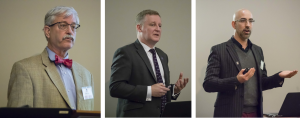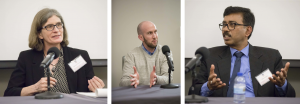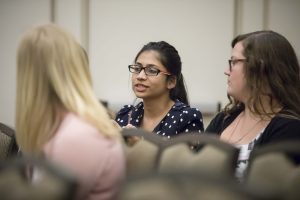One Health: The Health of All for the Health of One
Robin Holland
Life is the most valuable item that any entity on Earth possesses. We fight for it, we work for it, and we strive to make it last as long as possible. Civilizations have waged deadly wars over land claims so that their inhabitants may live in a greater area or use greater resources. Historians, philosophers, artists, agriculturalists, economists, biologists, physicists, engineers, chemists, and every trade in between are, at their core, seeking to interpret, understand, or improve life. Prior to the expansion of human travel through fundamental technologies that created an interconnected world, societies were disparate. The health of one individual society only relied on that society’s immediate surroundings. However, times have most certainly changed, and the world has never been as interconnected as it is today. Never before has humanity faced the challenge of understanding and prolonging life on a global scale.
The One Health initiative seeks to assemble various disciplines, working together on local and international scales, in order to improve the health of all living entities on Earth. Certainly, the application of One Health within small communities has the potential for long-standing benefits, but by living in the interconnected world of today, society holds the burden to act on a global scale. Major threats continue to plague life on Earth, ranging from income inequality and class warfare to epidemics of disease and global warming. Today is the time for global society to assemble and address these challenges if humanity desires to continue to live and prosper.
In 2017, the University of Illinois at Urbana-Champaign began its 150-year anniversary celebration. Since its inception in 1867, the university has been a driving force for “learning and labor,” pushing students to learn of our history and challenges, toward discovering how we as a society can work together, through labor, to build a better future for those to come. It was therefore quite fitting that in celebration of 150 years of public service and education, the university hosted a symposium on the topic of One Health. The university has held a strong ground in interdisciplinary research and academic pursuits, with several institutes on campus bringing together individuals from vastly different fields in order to address fundamental societal problems. The topic of One Health rose through various organizations of the university, including the Infection Genomics for One Health research theme at the Carl R. Woese Institute for Genomic Biology, the Center for One Health at the College of Veterinary Medicine, and most promisingly, a new One Health course, workshop, and working group, spearheaded by a team of students. Global issues facing humanity are clear but complex. What is clear is that individuals from various backgrounds do indeed hold a passion to work toward curtailing the challenges that we face. Although global health issues are complex, the One Health initiative is a major driving force that, if executed to its fullest potential, holds the possibility to fundamentally change the course of global health.
On April 11, 2018, the University of Illinois at Urbana-Champaign assembled respected scientists and clinicians from all areas that encompass One Health, including human medicine, veterinary medicine, and environmental health. All speakers incorporated interdisciplinary studies into their work, emphasizing the role that the One Health concept has secured within their own field. The audience, too, encompassed a large variety of disciplines, including human medicine, veterinary medicine, entomology, ecology, public health, geology, microbiology, and students still early in their respective careers. Dr. Robert V. Tauxe from the Centers for Disease Control and Prevention (CDC) led the human medical perspective. Dr. Tauxe is the Director of the Division of Foodborne, Waterborne, and Environmental Diseases in the National Center for Emerging and Zoonotic Infectious Diseases at the CDC and is considered a foremost expert in food safety and foodborne diseases. He spoke of his numerous experiences of outbreak investigations, including those of E. coli O157 in Oregon USA, E. coli O104 in Germany, Vibrio vulnificus in Israel, Nipah virus encephalitis in Bangladesh, and the increasing threat of antibiotic resistance Shigella. Tauxe spoke of major challenges that he and his team faced when conducting outbreak investigations, including detection and characterization of a pathogen, development, and implementation of public health and safety protocols, and application of lessons learned to prevent of future outbreaks. Altogether, it was clear that outbreak investigations are complicated, multifactorial problems. In order to solve an outbreak, one must not be narrow-minded, focusing only on the human cases and sources of infection, as the world is rarely so simple. One must consider environmental exposures, whether they be animal, plant, chemical, or other abiotic encounters. One must assemble a coherent series of connections between observations in order to determine the root cause of an outbreak, thus leading to effective countermeasures and control. Dr. Tauxe spoke of the role that the One Health concept plays in outbreak investigation, and how ultimately it leads to improving health and well-being where outbreaks are continually more likely to occur in our ever increasingly interconnected world.

Although humans are the predominant sentient living species on Earth, our population is minuscule compared to that of non-human, animal life. To this end, Dr. Stuart Reid, the Principal of the Royal Veterinary College of London and specialist in veterinary epidemiology and veterinary public health, provided a veterinary medical perspective. Dr. Reid spoke of a rather interesting series of investigations that he led into understanding the dynamics of disease transmission between populations of animals and humans. Dr. Reid initially published a paper in which his group’s findings supported a model that animals were not the source of human infection with antimicrobial-resistant pathogens, but rather that human populations were the source. Although his group’s study was well conducted and thorough, the notion that humans were responsible for disease transmission to animals received considerable backlash, including statements such as “Reid and his colleagues owe society an apology.” Although critique is most certainly welcomed in science, the community response to Dr. Reid’s findings took a profoundly different tone. Even in the face of significant resistance, Dr. Reid and his group decided to move forward with a more ambitious study in order to rigorously evaluate their findings. A few years later, Dr. Reid and his group published another paper, this time in the prestigious journal Science, where they genetically analyzed hundreds of clinical samples from around the world, from vastly different populations of animals and humans. Their findings detailed a complex system of disease transmission, with infectious agents passing from humans to animals, animals to humans, with environmental factors intertwined throughout on an international scale. Dr. Reid’s work, like Dr. Tauxe’s, highlighted the role of One Health in disease transmission, and that if we as a society are to make significant progress to address global challenges, we must be apt to entertain new ideas, even if those ideas counter long-held beliefs.
“We see what we are trained to see, we hear what we are trained to hear.”
-Dr. Stuart Reid
Even as medicine seeks to improve the health of living organisms, whether they be human or animals, those efforts are, without a doubt, squandered if the environment is not incorporated into medical practices. Although the health of the environment is an equally placed cornerstone of the One Health initiative, the sheer size and impacts of the environment in global health are monumental. The air we breathe, the water we drink, the food we eat, and the land on which we live are all essential for life on Earth, and for Earth itself. How humans and animals interact with the environment, and how the environment changes due to human and animal activity, drastically affect global health from all vantage points. To address this aspect of One Health, Dr. Thomas Gillespie, an Associate Professor in the Departments of Anthropology, Environmental Health, and Environmental Sciences at Emory University provided an environmental health perspective. The work of Dr. Gillespie’s team spans several continents in its quest to understand how humans are shaping the environment through the transmission of diseases between populations. Dr. Gillespie spoke on his group’s work in Uganda, Tanzania, and Madagascar, where they observed higher levels of antimicrobial resistant bacteria among wild gorillas that had never received antibiotic therapy but that had been exposed even a little to humans. They observed that if wild populations of primates were in close proximity to humans, the primates were at a greater risk of contracting infectious diseases from humans, such as E. coli and Cryptosporidium, and that likewise, humans were at a greater risk of contracting diseases such as Ebola and AIDS. In one interesting facet of this research, scientists observed inter-species disease transmission not necessarily by direct contact, but rather through water and land, or through vectors such as mosquitoes and ticks. This indirect contact illustrates the impact that simple human activity may ultimately have on our surroundings. In no better instance are the concepts of One Health exemplified. Through human activity, landscapes and ecosystems change, leading to profound effects on wildlife health. This, in turn, feeds back to humans, negatively impacting disease transmission and the risk of outbreaks of infectious diseases. By implementing One Health concepts, the potential for minimizing the occurrence of environmental changes and disease transmission to potentially vulnerable wildlife populations is greatly increased.

In addition to keynote speakers from each of the main cornerstones of One Health, the symposia integrated panel discussions in order to provide discourse on different pressing infectious disease topics. The antimicrobial resistance panel was comprised of Dr. Brenda Wilson, who spoke of her work on an emerging strain of E. coli; Dr. Rebecca Smith, who spoke of a novel concept for modelling infectious disease whereby each bacterium is considered as an individual entity; Dr. Tauqueer Alam, who spoke on methodologies to identify antimicrobial-resistant Staphylococcus aureus; and Dr. Ken Ringwald, who discussed his innovative approach to track antimicrobial resistance using CRISPR technology. A second panel focused on multidisciplinary collaborations to address emerging infectious diseases, and was comprised of Dr. Marilyn O’Hara Ruiz, who discussed her application of geographical information systems to track the invasion of a new species of mosquito into the state of Illinois; Dr. Brian Allan, who spoke of his research in Kenya studying tick-borne diseases; Dr. Nohra Mateus-Pinilla, who spoke of chronic wasting disease and the challenges regarding its emergence and spread; and finally Dr. Srikanta Ghosh, who spoke of his work in India investigating tick-borne diseases.

Altogether, the panels, which included the keynote speakers, engaged in honest and thoughtful discussions with numerous audience members, ranging from senior scientists to young students. Even with a lengthy discussion on global issues and apparently insurmountable challenges we face, the symposia was best concluded by Dr. Ruiz, who stated that the greatest hope for tackling those challenges lies in students, for it is there where she observed a new wave of passionate, innovative, and driven individuals.
The One Health initiative stands at the foot of a monumental series of global challenges. One Health, at its essence, is indeed the intersection of human, animal, and environmental health. However, some still raise the question of what encompasses One Health. Dr. Reid stated that “We see what we are trained to see, we hear what we are trained to hear.” This statement holds particular weight regarding the definition of One Health and what it can accomplish, as it emphasizes that it must be comprised of expert individuals in various disciplines working together, rather than individuals who are diffusely trained in all aspects of One Health. The goals are vast, to improve global health on a far-reaching scale. But humanity is poised in a unique position of opportunity. Never before have we as a planet been so connected. Never before have we been so driven to combat global challenges. And never before has humanity been so educated and technologically advanced. If One Health is implemented successfully by the criteria described through movements across the globe, then truly through the lens of the health of all on Earth, will we achieve the health of everyone.



